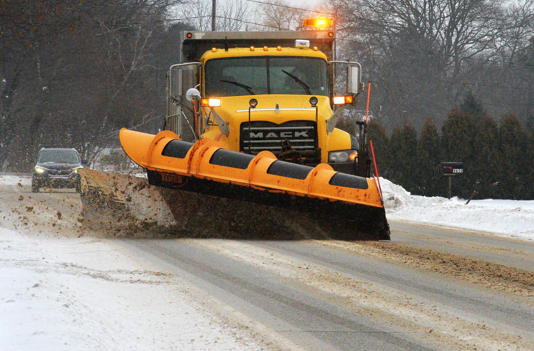These silly snowplow names are getting attention. Here are the best ones.
There’s Dolly Plowtown. Beyonsleigh. Saline Dion and Taylor Drift. Watch out for Clark W. Blizzwald, Han Snowlo, and Darth Blader.
Put down that novel – F. Salt Fitzgerald might be roaming a street near you this winter.
As snow blankets much of the United States in a rare winter storm that's impacting much of the country, plows and salt trucks with cheeky names are gearing up to pick up the mess from Massachusetts to Nebraska, Arlington, Virginia, to Wichita, Kansas.
Call it a winter craze sweeping the nation. Literally.
In the past few years, cities and states across the country have begun holding naming contests for snowplows and other winter weather vehicles. The goal: to add some levity to stressful storms, promote safe driving and shed light on the work of emergency response crews.
“We thought it would be a fun engaging way to connect and engage with Connecticut residents and commuters – all in the name of safety,” said Connecticut Department of Transportation spokesperson Josh Morgan. “It is a reminder to them to not crash into us, to keep it easy and slow down on the roads.”
Connecticut has hosted a naming contest for its residents for the past three years, Morgan said. Last year, the state’s Department of Transportation partnered with 40 local schools for the contest to teach young children how to safely navigate around plows.
Some of the winning entries included SnowBob Plowpants, Up2 Snow Good and Fast & Flurryous. Morgan expects this year’s winning names to be released by Friday.

A PennDOT plow truck heads west while clearing snow on Route 5 in Girard Township on Jan. 16, 2025.© GREG WOHLFORD/ERIE TIMES-NEWS/USA TODAY NETWORK
Chicago snowplow names unveiled
The city of Chicago on Wednesday announced the winners of its annual "You Name a Snowplow" contest. The names, selected from a group of 50 finalists, will be given to one snowplow in each of Chicago's six snow districts. Residents who submitted the names will get a chance to take a photo next to the named plow.
Several of the winning picks pay homage to the city
, including Lollaplowlooza, named after the Chicago's annual music festival, and Bean there, Plowed That, after the famous Cloud Several of the winning picks pay homage to the city, including Lollaplowlooza, named after the Chicago's annual music festival, and Bean there, Plowed That, after the famous CloudGate sculpture in the center of the city. Other winning names include Bozo the Plown, My Kind of Plow, Snower Wacker and Scoop, There It Is.
A new tradition
The quirk of naming snowplows isn’t unique to the United States. The trend appears to have begun in Scotland. Traffic Scotland's website the origins back to a 2006 naming contest for “gritters,” what they call plows, among school children in the country.
But Ryan Gilbert, a spokesperson for the national transportation agency, Transport Scotland, said the country didn’t officially launch its national contest until 2016. It was designed to bring attention to Scotland’s “Gritter Tracker,” which allows people to follow plows’ progress and see what roads around them have been treated.

Scotland’s Transport Secretary Fiona Hyslop visited the Burghmuir gritter depot in West Lothian to see “Scotland’s Bravest Gritter," a vehicle named by Scotland’s Bravest Manufacturing Company.© Ian Rutherford
Today, the country’s entire fleet of 240 Gritters have all been lovingly named by citizens through local radio, newspaper and school contests. The names range from pop culture icons to snow puns.
Creativity knows no bounds – so the agency had to set some. Titles need to be less than 25 characters long, or under four words. Inappropriate entries and ones with swear words are not accepted.
This year’s fleet includes Mr. Snow-it-all, Salt Shaker, Carrie Bradthaw, Sled Zepplin, Icetalavista Baby, Brine Freeze, to name just a few.
Municipalities across the United States have adopted similar snow plow trackers. Arlington County in Virginia began its naming contest this year to spread the word about its snow and ice map.
“We wanted it to be a fun way for people to follow along, but also bring awareness to just the hard work that these crews do,” Kiara Candelaria Nieves, a communications specialist for the county’s department of environmental services, said of the emergency response crews and private contractors that operate the plows.
Other winning names
If you live in a state that sees snowfall, chances are the plows that scrap your streets have nicknames, too.
Alaska, Nevada, Minnesota, Vermont, Delaware, Massachusetts, North Dakota, New Hampshire, Connecticut and Ohio all have launched similar contests.
Here are some of the winning names from coast to coast.
- You're Killin' Me Squalls
- Ope, Just Gonna Plow Right Past Ya
This article originally appeared on USA TODAY: These silly snowplow names are getting attention. Here are the best ones.
